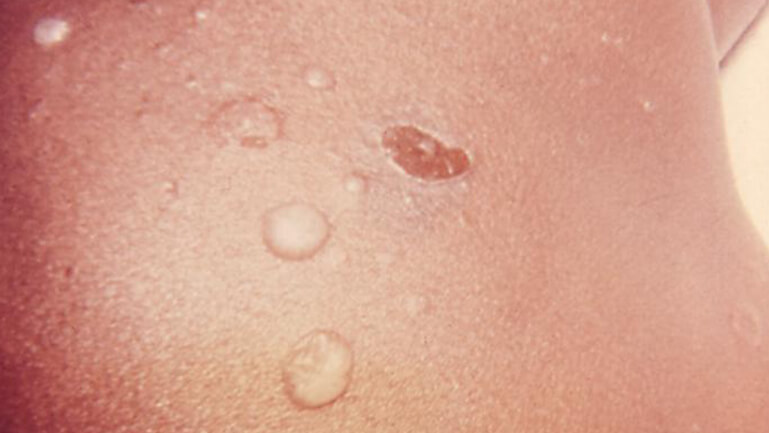Reduziere Rosacea
mit Sanubiom SkinCare Protect mit Phage Technology
Rosacea

The word rosacea comes from the Latin “rosaceus” and means “redness”, which already says a lot about the consequences of the inflammatory and frequently occurring skin disease. Rosacea leads to visible redness due to dilation of the blood vessels under the skin. The nose, cheek and forehead are most commonly affected. It can be recognized by large, red, scaly and sensitive areas and normally progresses in episodes.
But the eyes can also be affected and dry out.
Impetigo contagiosa, also known as weeping skin rash, is a highly infectious bacterial skin disease that occurs mainly in children and newborns. The skin disease is also known as impetigo vulgaris, grind blisters, grind lichen, pus lichen, pus lichen, bark lichen, smear lichen, dragon’s foot, dragon’s foot.
The cause of the skin disease is an infection triggered by bacteria that can spread in the skin with specific pathogenicity factors and even destroy tissue. This skin disease occurs in two forms, a large-bubble and a small-bubble form. Staphylococcus aureus is predominantly present in both the small- and large-bubble forms.
Both forms, especially the small-bubble form, can also be caused by Streptococcus pyogenes (group A streptococci). Mixed infections are also possible.
As the skin disease spreads through smear infection, it occurs mainly in children in schools and nurseries.
However, all other age groups can also be affected, especially people with atopic eczema, as scratching the skin allows the pathogens to penetrate deep into the skin layers.
In impetigo contagiosa, a distinction is made between the small-bubble and large-bubble variant. Both forms of the disease begin predominantly on the face with red spots, which quickly turn into blisters filled with watery fluid. A narrow inflammatory halo also develops around the blisters.
Small-bubble impetigo contagiosa
In small-bubble impetigo contagiosa, the blisters are not always visible. The blisters burst quickly as their walls are very thin and the blister base is very weeping due to exudation. Characteristic honey-yellow crusts form on a reddish background when the liquid dries.
Large-bubble impetigo contagiosa
In large-bubble impetigo contagiosa, numerous blisters appear and are initially filled with water-clear fluid, which changes color from whitish-gray to creamy-purulent. If these blisters burst, reddened, eroded surfaces appear with a moist sheen. In comparison to small-bubble impetigo contagiosa, hardly any incrustations occur here.
According to the German Dermatological Society, the treatment guidelines prescribe the use of systemic antiobiotic therapy in serious cases. As the infection is caused by bacteria, hygiene also plays an important role in the treatment of impetigo contagiosa. Regular hand washing, avoiding scratching the affected areas of skin, hot washing of clothing and towels curb the infection and prevent re-infection. In addition, the possibility of scratching with short fingernails should be reduced.
Ointments containing antibiotics can be used for treatment. SkinCare Protect, which restores the balance of the skin flora with the help of Phage Technology, is suitable for killing off bad bacteria.
The incubation period lasts between two and ten days, but can also take longer. There is no longer any risk of infection until the purulent areas of skin have healed. If the therapy against impetigo contagiosa is applied consistently, the disease heals without further consequences. The scales and crusts can be removed from healthy skin or fall off on their own. In rare cases, the disease can also reach the deeper layers of the skin and cause inflammation of the nail bed or abscesses. The patient may only return to kindergartens and schools after the diseased areas of skin have healed. 5% of affected patients suffer an inflammatory reaction of the kidney after the infection, but this usually heals without consequences.
The probiotic skin spray SkinCare Protect from Sanubiom promotes the growth of good bacteria. In addition, the phage technology it contains ensures that the bad bacteria are specifically eliminated.
This rebalances the skin, eliminates irritation and reduces redness.
SkinCare Protect uses Phage Technology to restore and maintain the skin’s natural balance.
Bacteriophages (e.g. Staphylococcus aureus phages) are used to contain the spread of specific bacteria (e.g. Staphlococcus aureus).
SkinCare Protect has therefore proven its worth as skin care for acne, rosacea and neurodermatitis and can be an alternative to medication.
SkinCare Protect also contains a specially developed nutrient medium that promotes the growth of good bacteria.
You can find more information on phage therapy at www.phage.help
Author: Christian Unterlechner, Dipl.-Ing. (FH), MBA
“From our own experience with neurodermatitis – and the long path of suffering associated with skin conditions like this – we started to look for alternative solutions to drug treatments. We are very happy to share the knowledge and experience that has gone into the years of developing our SkinCare products with you.”
Share post